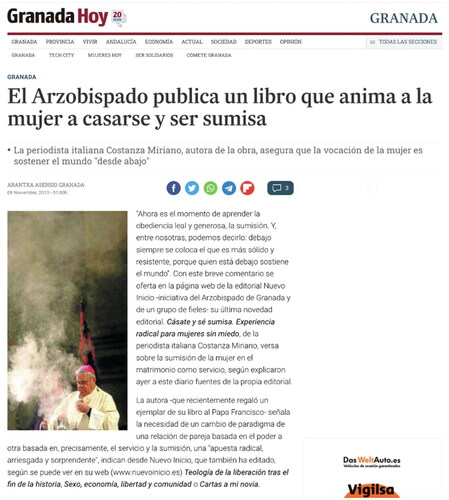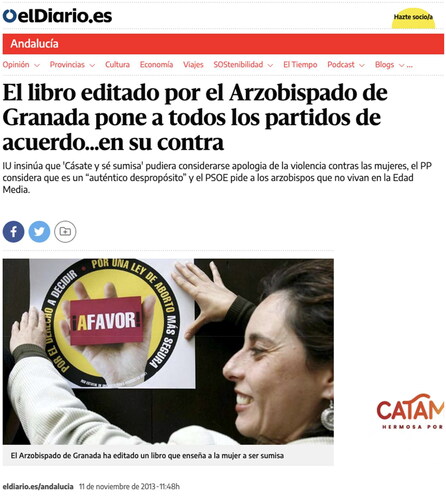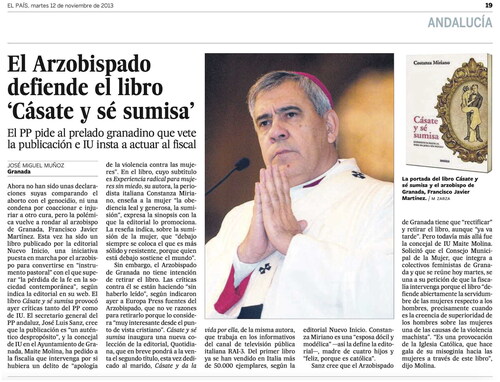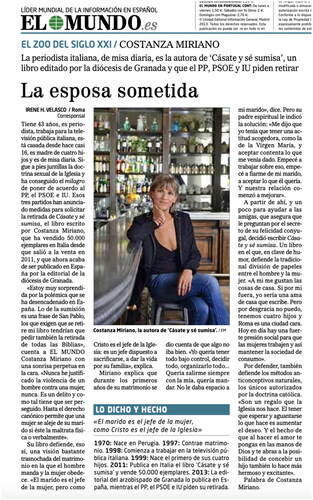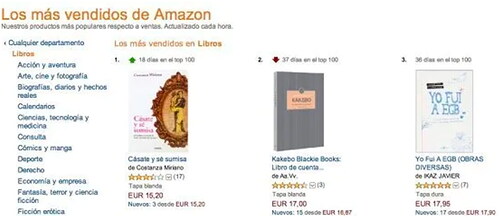Abstract
Conversations regarding moral values are increasingly becoming a pivotal dimension of public discourse. This paper presents a new approach to unacceptable discourse. Drawing on René Girard’s cultural anthropology and Luciano Elizalde’s dissent management theory, this work develops a scale of situations of dissent, such as controversy, polemic and public discourse scandal. It offers a detailed study of the polemic raised by the book Marry Him and Be Submissive, a process of dissent which was generated in Spain in November 2013 on the occasion of the publication of this Italian bestseller and lasted until January 2014. The book was written by the Italian journalist Costanza Miriano and translated and edited by the Archdiocese of Granada. The case study uses a triangular approach to discourse analysis, which aims to comprehend the enunciator’s legitimacy and social positioning, the communication context in which the debate takes place, and the characteristics of the public discourse. A central element regards how reactions are organized around the signifier 'submissive’ and the different frames of interpretation assigned to this word, in what will be called 'feminist’ and 'post-feminist’ paradigms. Mechanisms of dissent and consensus are explained, and takeaways and actors’ strategies are discussed.
1. Scandalization and public debate on values
Conversations regarding moral values are increasingly becoming a pivotal dimension of public discourse (Cannata Citation2022). Severe discursive transgressions against a community’s fundamental principles and norms can trigger highly unstable dissent processes, imperilling the social standing and reputation of public figures due to indignant accusations and the societal dissemination of such dissent (Thompson Citation2000; Elizalde Citation2017). Ekström and Johansson (Citation2008) termed this phenomenon 'talk scandal’. According to Haidt (Citation2012), the contemporary public arena has seen a diminishment in incentives for consensus positions. Instead, it has evolved into a 'dichotomous polarization’ (Amossy Citation2016, 30) featuring frequent delegitimization of opponents and the framing of communication scenarios in terms of confrontation or culture war.
This article presents a new approach to unacceptable discourse. Drawing on René Girard’s cultural anthropology (Girard et al. Citation2006) and Luciano Elizalde’s dissent management theory (Elizalde Citation2017), this work develops a scale of situations of dissent based on the risk to the accused, the object of discussion, and the nature of the relationship between social actors (see ). First, a controversy is about ideas, there is no risk to the social position of the actor, and the relationship is characterized by confusion. Then, a polemic is about interests or values, there is no risk to the social position of the actor, and it is a confrontational, often polarized relationship. Finally, a scandal is triggered by a moral transgression, there is a real risk for the social position of the actor, and it is a confrontational relationship marked by indignation and anger. Girard adds that a scandal occurs when a social process of unanimous accusation is organized and tends to be resolved through the scapegoat mechanism.
Table 1. Matrix of situations of dissent (Cannata based on Elizalde [Citation2017]).
The concept of dissent management makes it possible to identify social situations that appear scandalous because they provoke outrage and calls for punishment, but in fact, those situations are not characterized by unanimous accusations. This scenario is common in polarized contexts, where one group is scandalized while another is strengthened in their stance, both in response to the same situation.
On its behalf, polemical discourse – discourse that involves confrontation without undermining the accused’s social position within his or her reference system – can be strategic, emerging from a struggle of interests, or emotional, triggered by values and worldviews. Affective polemics, through the spontaneous or calculated activation of criticism of the transgression of values, tend to invalidate the opponent. They generate heated, intense debate.
Because of their high emotional tension, polemics may appear to be scandals of public discourse because they are born out of processes of scandalization. In this matrix, however, there is not a scandal without an actual threat to the position of the accused. The case of Marry Him and Be Submissive begins with a process of scandalization, but it quickly takes shape as an affective polemic and, eventually, is deactivated by becoming a controversy. The case presents a spiral of dissent in both factions of the dispute: the more the book is criticized in one sector of society – the political and media sphere – the more it is defended in the Catholic sector, until the book to be censored becomes a bestseller. These kinds of theoretical distinctions between types of dissent will help in deepening the study of public debates about values, the dynamics of indignant accusation, and discourse management ().
2. Purpose and methodology
In March 2012, the Catholic information portal Religión en Libertad published an interview with Costanza Miriano due to the publication in Spanish of her Italian bestseller Sposati e sii sottomessa: Pratica estrema per donne senza paura (2011), which was translated by Nuevo Inicio Editorial (of the Archdiocese of Granada) as Cásate y sé sumisa: experiencia radical para mujeres sin miedo [Marry Him and Be Submissive: Radical experience for women without fear] (Religión en Libertad Citation2012). In the following year, the book generated great controversy, including various social condemnations and even proposals for legal censorship, at the same time that it became a bestselling book. This phenomenon anticipated what would later be called 'cancel culture’ and revealed some of its paradoxical effects: the very broad condemnation coming from the official paradigm of values in the political public sphere was contrasted by the private adhesion of consumers.
I propose to analyse this case in order to identify mechanisms of activation and deactivation of dissent. The study of mechanisms (Bunge Citation1997) will be carried out by process-tracing the key events of the case, which took place in Spain from November 2013 to January 2014.
The case will be approached from the public position of the accused, that is, from the perspective of the Archbishop who published the book, and the author – a rare perspective in scandal studies. This outlook allows for takeaways for public discourse and dissent management. In following this method, three objectives are proposed:
to analyse the process of transgression, accusation and management of social condemnation;
to delve into the controversies over values and the functioning of the processes of dissent activated by discursive transgressions;
to point out lessons learned regarding the management of public discourse and social dissent.
The documentation of the case was based on 1,118 articles from Spanish newspapers taken from the MyNews database, with special attention to the Joly Group in Andalusia. Although the controversy was of national relevance, the epicentre was in Granada. In addition, the author’s blog (https://costanzamiriano.com/), the websites of the Office of the Archbishop of Granada and the publishing house, and the repercussions on social networks were used.
The case study is presented using a triangular approach of public discourse analysis (Cannata Citation2014), which aims to comprehend the enunciator’s legitimacy and social positioning, the communication context in which the debate takes place, and the characteristics of the public discourse itself. In this case, a central element is how reactions are organized around the signifier 'submissive’ and the different frames of interpretation assigned to this word, in what will be called 'feminist’ and 'post-feminist’ paradigms.
These processes of scandalization particularly affect the Catholic Church, which has suffered a double erosion: on the one hand, its public position on certain moral issues has lost acceptance; on the other hand, the institution itself has experienced a process of loss of social legitimacy in the West (Cannata Citation2022). Controversies over values can be an opportunity to express the vision of Catholics on sensitive issues, but they can also be processes of erosion of legitimacy that hinder the mission of the institution. Determining the extent to which entering into a polemic can be productive or destructive is a constant challenge for all institutions that develop their activities in increasingly pluralistic and complex contexts.
3. The polemic over Marry Him and Be Submissive
3.1. Presentation and background of the accused
In her blog, Costanza Miriano introduces herself primarily as a married mother of four. She graduated with a degree in Greek and Latin Literature and currently works as a journalist for the Italian public television network RAI. Additionally, she is a contributor to various newspapers, writing on family dynamics, education, and love relationships. She collaborates with the Pontifical Council for the Laity of the Holy See. She also points out that her blog has received over three million views in the last two years ().
Figure 1. Costanza Miriano. Source: https://costanzamiriano.com/foto/.

For his part, after engaging in extensive studies abroad and developing a career centered around working with young people, Francisco Javier Martínez was ordained as a very young auxiliary bishop of Madrid at the age of 37 in 1985. Then, he was appointed by John Paul II to lead the Archdiocese of Granada in 2003.
In 2009, Archbishop Martínez gained media attention for delivering an Advent homily wherein he drew a comparison between abortion and 'silent genocide’. He alleged that a law passed during the Rodríguez Zapatero administration put doctors in a similar position to the officers in Hitler’s concentration camps (Diario de Sevilla Citation2009). Moreover, some have interpreted a segment in the homily as an attempt by the Archbishop to diminish the gravity of rape against women who have undergone abortions. Later, the bishops of southern Spain explained that the Archbishop was misunderstood, but the PSOE accused Archbishop Martínez of promoting violence against women. A few days later, in January 2010, the Granada Hoy newspaper reported on a Facebook 'war’ sparked by the prelate’s statements, with thousands protesting against and around 800 in favor (Granada Hoy Citation2010). Additionally, a 2014 profile in El Mundo characterized Martínez as 'one of the most critical prelates against the policies of Rodríguez Zapatero’ (El Mundo Citation2014).
3.2. Context of communication
The Spanish version of the book was published in 2012 by the publishing house Nuevo Inicio, an initiative of the Archbishop of Granada and a group of faithful Catholics. The book had sold 50,000 copies and 16 editions in Italy, auguring translation into several languages; in 2013, it was translated into Spanish and Polish ().
The Vatican’s official newspaper, L'Osservatore Romano, published a review of the book in 2011, calling it 'amusing and ironic’. In the same year, the left-leaning newspaper La Repubblica and the fashion weekly Elle included recommendations for the book in features on marriage. In June 2012, the author participated in an interview on RAI 1, where she had the opportunity to comment on the content of the book, which was presented as a great bestseller.
In her explanations to the media, Miriano refers to the origin of the expression in the title of the book to the letter of St. Paul to the Ephesians, Chapter 5, verses 21-25: 'Wives, submit yourselves to your own husbands’. Both in the title of the book and in her explanations, the author proposes a meaning of ‘submissive’ in the sense of avoiding the ‘tendency to control and manipulate’ that, in her opinion, women have. In contrast, she says, the man, who tends to focus on himself, should ‘give his life for her’. In Italy, the word ‘submissive’ is provocative, but Miriano’s version is approached with curiosity. It may trigger controversy and even opposition because of disagreement with the model of woman she proposes, but it does not cause scandal.
While Miriano emphasizes that the invitation to be submissive is issued only to women; John Paul II interprets the meaning of St. Paul’s text as 'mutual submission’: 'Whereas in the relationship between Christ and the Church the subjection is only on the part of the Church, in the relationship between husband and wife the “subjection” is not one-sided but mutual. In relation to the “old” this is evidently something “new”: it is an innovation of the Gospel’ (John Paul II 1988, 24).
3.3. Events
Saturday, November 9, 2013: 'a book that teaches women to be submissive’
The news portal Granada Hoy, of the Joly group of Andalusia, published an article entitled 'The Office of the Archbishop of Granada publishes a book that encourages women to marry and be submissive’ (), based on a press release sent by Nuevo Inicio Editorial, 'presided over by the Archbishop of Granada’. At the bottom, the article adds: 'The Italian journalist Costanza Miriano, author of the book, assures us that the vocation of women is to support the world “from below”'. This information garnered significant attention in media coverage and on social networks. According to the MyNews database, 53 articles regarding the subject were published on that day. Most of the comments conveyed an outraged tone and many included derogatory language such as 'living in the Middle Ages’, 'crazy people’, 'what absurd advice!!!', and 'sexist retrogrades’.
An article published by Agencia EFE elevated the matter to a national scale, resulting in 35 articles with identical headlines: 'The Archbishop of Granada publishes a book that teaches women to be submissive’. The text stated: 'The book by Italian author Costanza Miriano has been a bestseller in Italy and is inspired by the phrase “wives, be submissive to your husbands”, from St. Paul to the Ephesians’.
The outraged reaction was widespread and quickly triggered institutional responses. For example, a publication of the El País on Twitter has had 834 retweets. The comments reveal indignation: 'They shuffled other titles, such as “marry and be his bitch”'; 'inquisitor’; 'they go back several centuries’; 'social cancer’; 'a joke in bad taste’; 'misogynist and anti-democratic institution’; 'it promotes gender violence’; 'idiots’. Associations with Islam emerged, pointing out ironically that the prologue had been written by two imams. The book Fifty Shades of Gray was also mentioned a few times, distinguishing between playing at submission and actually proposing it.
The headlines focus on the Archbishop of Granada as the subject of the action of publishing the book. The author is in second place. The news articles report that the book has sold 70,000 copies in Italy and it is presented with a phrase taken from the publisher’s webpage: 'Now is the time to learn loyal and generous obedience, submission. And, between us, we can say it: underneath always stands the one who is more solid and resistant, because she who is underneath supports the world’ (). It is reported that the book has a second volume, entitled Marry Her and Die for Her, which will soon be published in Spanish.
About Costanza Miriano it is highlighted that she is the mother and a journalist for RAI, the Italian public television. It is indicated that, as she is a Catholic, '(almost) always in a good mood’. About the word 'submissive’, it is mentioned that the author refers it to 'service’ and that she attributes the adjective to herself in her presentation: 'She is “submissive” – at least she likes to say so’. It is also explained that it is inspired by St. Paul’s letter to the Ephesians and that she has presented a copy to Pope Francis.
The social media impact on the first day indicates that the controversy is a more media-driven phenomenon rather than a social media one. Only 10 posts have more than 10 retweets, and the majority are from journalists or media outlets.
Sunday, November 10, 2013: an ‘intolerable’ book
On Sunday, the news appeared in the print editions of numerous newspapers and followed the inertia of the previous day in the digital media. According to the MyNews database, it reached 48 publications that day. A similar tone is maintained, but the attribute of ‘bestseller’ in Italy is added to several headlines. At the same time, opinion columns echoed the outrage with statements such as 'it’s intolerable’.
Monday, November 11, 2013: 'all parties against the book’
At the beginning of the week, a new step in the upward curve of dissent is generated, with a total of 118 articles. The coverage, once again, is crossed by news agency cables that are replicated by numerous media. The important milestones of the day, which are reflected in a homogeneous news coverage, relying on information from EFE and Europa Press agencies, are as follows:
Izquierda Unida of Granada asks the Public Prosecutor’s Office to act against the book as one that advocates violence against women and demands that the City Council of Granada, whose presidency is in the hands of the right-wing Popular Party (PP), act in repudiation of the book.
The PSOE (Spanish Socialist Workers’ Party) demands that the Women’s Institute and Ana Mato (Minister of Health, PP administration) issue a statement on the book. It also accuses the Catholic Church of receiving money from the state to advertise 'sexism’ and 'discrimination’.
They ask the Archbishop of Granada to withdraw his support for the book.
Numerous women’s associations demonstrate against the book. For example, Ana María Pérez del Campo, president of the Association of Separated and Divorced Women, points out that this book teaches 'the opposite’ of Pope Francis.
The PP of Granada asks the Archbishop to 'rectify’ the situation and withdraw the book.
The Archbishop of Granada sees no reason to withdraw the book, which is the translation of a 'bestseller’.
The agency Europa Press reports a new framing of the Archbishop’s Office: 'they criticize the book without having read it’. For its part, the Granada Laica Association (GLA) has asked the Archbishop to withdraw his support for the book. The spokesperson of GLA, Manuel Navarro, has considered in declarations to the EFE agency that the Archbishop has become an 'accomplice’ of an 'aberrant’ book, which goes against human rights and equality. Some media highlight that the political system expresses itself to be unanimously against the book. In addition, in the comments and complementary references, the subject of sexual abuse perpetrated by clergymen appears ().
Tuesday, November 12, 2013: articles 'beyond the title’
The topic is still very present in the media coverage, with 79 articles. The dialectic of the coverage takes place between the Archbishop who defends the book, the PSOE that demands its immediate withdrawal, and the comparisons to the Imam of Fuengirola made by Izquierda Unida. Imam Mohamed Kamal Mostafa, of Fuengirola, spent three weeks in prison for publishing a book in which he explained how to beat a woman without leaving a trace ().
An article in elDiario.es summarizing the contents of the book – and so far the only article that goes beyond the title, in a response to the statements that 'they criticize it without having read it’ – stands out on this day. The journalist Miguel Ortega Lucas adopts a position of critical analysis and his framing places the book in a socially acceptable place: 'the book is thick, but entertaining, the author is intelligent and not a fanatic’. He also adds that the tone between 'Old Testament and Superpop’ may explain its success in Italy. Finally, on the site specialized in religious topics Aleteia.org, Feliciana Merino shares her opinion on the book in a column entitled: 'No one wants women inferior to men or locked up at home’. Her point is that critics have been carried away by a provocative title without considering the context and the ironic tone.
Wednesday, November 13, 2013: Miriano’s voice in the media
The media proliferation continues: 98 articles according to the MyNews sample, with great influence in the narrative of the Europa Press and EFE cables. Furthermore, opposing groups organize campaigns: one on Change.org to withdraw a 'misogynist’ and 'shameful’ book that reaches 17 thousand signatures and another one by the Christian association Enraizados.org, that achieves 4 thousand signatures in the first hours, to defend 'religious freedom and freedom of expression against the unjustified and totalitarian attacks on the Archbishop of Granada for publishing Cásate y sé sumisa’.
Meanwhile, the Bishop of Bilbao distances himself from the book in a press conference, criticizing it because it sows ambiguity and 'does not reflect what the Church thinks’ (about marriage).
On this day, the author’s voice appears for the first time in the media, with two interviews: one to the radio Onda Cero of Granada and the other to the Agencia EFE. In both interviews she maintains a similar narrative:
They criticize without having read the book: 'All the commotion that has formed in Spain shows me that no one has read the book’.
Surprised by the controversy: 'I am astonished. In Italy there was no controversy, in fact it was very well received, and the Catholic newspaper L'Osservatore Romano called it an amusing manual of evangelization’.
Rejection of gender violence: 'I don’t know how much weight the word “submissive” will have in Spanish, but I certainly do not instigate violence in any case and even less do I seek to stop women from being free or independent. My goal is to help recover loving relationships’.
Frame of attack to the Archbishop: 'The aim of the polemic is to attack the Archbishop’.
Association of his phrase with the Bible: 'The phrase is from St. Paul, so they should withdraw all the bibles from the market’.
The Catholic news portal Religión en Libertad makes a positive assessment of the elDiario.es article by Ortega Lucas because he judges the book 'having read it’ (Religión en Libertad Citation2013). The portal points out that, after reading news among hundreds of publications, it found only one journalist who took the trouble to read the book. It concludes with a link to the publisher’s website, where the book can be purchased, in order to talk about it, 'having read it’.
Finally, the Public Prosecutor’s Office rules out starting an investigation and headlines proliferate saying that the Archbishop of Granada 'ignores’ the criticism and publishes the second book. Opinion columns also begin to appear that, without necessarily agreeing with Miriano, criticize the scandalized reaction, with frequent reference to the fact that there was no controversy over the book Fifty Shades of Gray. In social networks, a negative approach continues, with publications that emphasize the idea that it promotes violence against women and seek to ridicule the book ().
Thursday, November 14, 2013: 'the Archbishop’s habitual tone could not have helped many to believe in the good faith of the book’
With 37 articles published, the intensity of the media impact is lower. There are no significant events that mobilize the development of the case. At this point, the public dynamic is organized into two rival coalitions. A new article by Ortega Lucas in elDiario.es feeds the moderate interpretation of the case, with the following headline 'The controversy and its edges’. He takes on the task of making a critical analysis of the book, but his denunciation only goes so far as to mention that the 'irony’ provokes a 'calculated ambiguity’. In this sense, he nourishes the hypothesis that the positioning of the Archbishop of Granada may have been more decisive for the polemic than Miriano’s book itself: 'The tone habitually used by the Archbishop of Granada could not have helped many to believe in the good faith of the famous book’.
One week after the start of the polemic: Friday, November 15 and Saturday, November 16, 2013
Of the more than 70 pieces of news – according to MyNews – of these days, 54 correspond to a statement from the Archbishop of Granada. The most reproduced headline is the following: 'The Archbishop of Granada defends the book and says that abortion does promote abuse’. With this intervention, abortion and divorce, presented as the real generators of violence in society, enter into debate. In this statement, the 'gross manipulations’ and 'gratuitous disqualifications’ are deplored, and the interpretation of an attack on the Church is promoted: 'It is rather about damaging the only institution (…) that resists being tamed by the roller of the dominant culture: the Christian people’. It is also recalled that 'the book has been positively recognized as good evangelizing by L'Osservatore Romano’, therefore, it is shown that 'the position of the publisher in these two books is in accordance with the teachings of the Church’ – in response to the Bishop of Bilbao. Finally, the Archbishop again asked that the criticisms be based on concrete passages from the book: 'Whoever makes such accusations regarding the book must be rigorous and specify the page and paragraph where the slightest justification or excuse of any type of violence appears’. At the same time, the general press – such as El Mundo – published an article summarizing the case, giving a voice to Miriano and her point of view ().
Sunday, November 17, 2013: Miriano refines her positioning and seeks to build bridges between the Church and feminism
On Sunday, elements of the general coverage of the polemic are recovered. For example, a full-page article in El País, focused on the figure of Archbishop Javier Martínez. In turn, Miriano grants an interview to the Huffington Post (Carretero Citation2013), in which she refines her position and brings it closer to that of John Paul II, offering a more inclusive interpretation of the word 'submissive’, as an attitude proper to both spouses: 'Marriage should be above all a place of mutual conversion, a place where both strive to offer the other the best of themselves. And in this we must help one another, because as St. Paul says, we are “mutually submissive”'. At the same time, she now stresses that the only violence against women in this story is that she is suffering, by being pressed to censor her book. She emphatically denies that the book promotes violence against women. On the contrary, from her perspective, it promotes equality between women and men: 'The book may or may not be liked, that’s obvious. But to say that there is an incitement to violence against women is pure madness. I don’t know about you, but in Italy the very thought that the equality of men and women can be questioned is ridiculous. The whole thing is ridiculous’. She also establishes positive points of contact with feminism.
Week of Monday 18 to Sunday 24, November, 2013: negative institutional repercussions
The inertia of isolated news and repercussions in opinion forums continues. The tension remains between furious attacks such as 'The Costanza scandal’ or nuanced analyses such as 'The delicate concrete mixer’. In turn, Alfa y Omega, a Catholic publication from Madrid, publishes an open defence of the book.
This week, the Junta de Andalucía (Andalusian Regional Government) asks again for the book to be withdrawn. In addition, the Congress of Deputies issues a unanimous declaration rejecting publications that call for the submission of women. Finally, the spokesman of the Episcopal Conference denies that the submission of women is an evangelical value.
November 25 and 26, 2013: speech by the Minister of Health on the day for the elimination of gender violence
Ana Mato, Spain’s Minister of Health, Social Services and Equality, intervenes in the case requesting the book to be withdrawn because it disrespects women. This new milestone reaches about 70 pieces of news in two days, according to the MyNews database. The minister, in declarations to RTVE gave assurance that she does not agree at all with ‘either the title or the content and would like, and have requested, that this book be withdrawn’. She also announced that a few days before she had asked the Women’s Institute to send a letter requesting the withdrawal of the book.
November 26, 2013: record sales on Amazon.es
Several media outlets announce that the book has become a bestseller on Amazon.es. Comments manifest the defensive narrative: 'When politicians of all parties want to censor a book it means it is a must-read’; 'It is an exaltation of the figure of women’; 'Above all it presents a way of looking at the family that is very different from what is currently preached’ ().
Chronology of the final repercussions: court case, freedom of expression and international mentions
November 27, 2013: the Andalusian Observatory of Gender Violence complains against the book.
November 28, 2013: the Women’s Institute studies taking the book to court.
November 30, 2013: young leftists stage a 'submissive wedding’, a critical parody, next to the Cathedral of Granada.
December 2, 2013: an opinion column entitled: 'The Unsubmissive Archbishop’ (by Magda Trillo) is published in Granada Hoy and all the Grupo Joly network. After a long and detailed analysis of the controversy, she takes a position on the debate on freedom of expression, recalling that, if censored, it would be the first book censored since the end of Franco’s dictatorship.
December 3, 2013: Granada Hoy publishes a column entitled 'Freedom for all’, on freedom of expression, recalling that, if Miriano’s book is banned, Fifty Shades of Gray and Justine by the Marquis de Sade should also be analysed. A low-volume debate continues for several days on freedom of expression, censorship, and submissive practices in sexual relationships.
December 12, 2013: Express publishes an article in the United Kingdom, in which it mentions the existence of an anonymous video repudiating the book. This information is not published in Spain.
December 14, 2013: In an interview on BBC News Night, Miriano, when asked why they wanted to ban her book in Spain, explains with some irony that it must be because of the word 'cásate’ (marry him), as she has researched, and there are other books with the word 'submissive’ in the title, such as Learning to be Submissive and Diary of a Submissive Woman ().
December 17, 2013: the Prosecutor’s Office requests information about the book. The process will determine whether to open criminal investigation proceedings.
December 23, 2013: the news coverage is relaunched with more than 70 articles about the publication of the second book, Cásate y da la vida por ella (Marry her and give your life for her).
January 9, 2014: Miriano and her husband give an interview to Alfa y Omega, in which they relativize the accusations of machismo and show a couple in an equal relationship giving their opinions on different issues (Vázquez Citation2014).
January 13, 2014: Anonymous hacks the website of the Archbishop of Granada and generates a wave of more than 40 news items in two days.
January 16, 2014: Ideal de Granada states that the book is sold out in bookstores. In turn, in Alfa y Omega, Margarita Fraga Iribarne publishes a humorous column celebrating the success of the book through a parody of the censorship attempt, entitled: 'Cásate y… sé tú misma’ (Get Married and… be yourself).
January 24, 2014: the Prosecutor’s Office of Granada opens criminal investigation proceedings against the book Cásate y sé sumisa, and generates another wave of 60 articles. The Granada Municipal Women’s Council – made up of 67 associations – is asked to send a copy of the book for analysis, detailing those expressions that could be subject to criminal reproach.
January 27, 2014: the Archbishop’s Office told EFE that they are 'absolutely convinced’ that the book has no criminal problem and that they will respect the work of the Prosecutor’s Office.
April 14, 2014: the Prosecutor’s Office files the case on the book Cásate y sé sumisa, generating 90 articles. The archiving decree issued by the delegated prosecutor of the Section of Violence against Women in Granada rules that the book does not contain unlawful statements that undermine the image of women or contain discriminatory discourse. Therefore, the content of the work is not criminal, since, according to them, it contains the 'manifestation of a religious ideology’.
4. Case analysis
4.1. A word of scandal: Interpretations collapse over the word ‘submissive’
The textual transgression derives from the book’s title: Marry Him and Be Submissive. Although the focus is on the term 'submissive’, the surrounding context of its first media appearance is determinant. The book’s introduction on the publisher’s website states: 'Now is the time to learn loyal and generous obedience, submission. And, between us, we can say: the one who is more solid and resilient always takes the bottom position because the one below holds up the world’. In this initial conceptual construction, the word 'submissive’ is modulated by 'obedience’ and 'being below,' which immediately triggers negative connotations regarding women’s dignity. Another key aspect to consider is the interpretation of the title in relation to the speaker’s perspective: initially, the Archbishop of Granada – positioned as a cultural warrior – is foregrounded, and the author, a young modern-looking woman, is in second place.
The term 'submissive’ is associated with St. Paul in the narratives of both the publisher and the author. Yet, in numerous commentaries, it evokes semantic connections with the BDSM world – particularly associated with the book Fifty Shades of Grey – and also with the notion of women’s submissiveness in Islamic cultures. Throughout the debate, there’s a recurring focus on the interpretation of the word 'submissive’: the textual genre, the author’s intent, the semantic context. Is it a provocation, an irony, an oxymoron? In what contexts is it valid? Who can use it and who cannot?
As is typical in polemics, reading contracts from various systems intersect: The political system interprets the submissive-obedience-archbishop-below scheme and reacts with unanimous outrage. The conservative Catholic system, bound by a communicative collaboration agreement, reads 'submissive’ as a provocation, understands the author’s post-feminist reinterpretation, defends the book, and purchases it. Those scandalized see it as regressive in a world advocating for women’s empowerment in both work and relationships. Conversely, the author approaches the topic from a post-feminist paradigm, focusing on the experience of dissatisfaction of empowered women. The author expresses this framework in various ways, with one notable manifestation being her surprise at the polemic. In her first public appearance, she comments: 'I am astounded. In Italy, there was no controversy; in fact, it was well-received, and the Catholic newspaper L'Osservatore Romano described it as an amusing evangelization manual’. Whereas in a BBC interview, when confronted by a heated interviewer, she mentions researching the word 'submissive’ and notes other books employing it without causing a stir, i.e., Diary of a Submissive Woman.
The term 'submissive’ spawns its own set of tensions within the Catholic sphere itself. While these debates might be seen as sporadic or incidental, they attracted substantial media coverage, notably from figures like the Bishop of Bilbao and the spokesperson of the Conference of Bishops. In such instances, interpretations of the term 'submissive’ diverge.
The final debate on 'submissive’ revolves around the book’s title versus its content. When interpreted within the book’s broader argument, 'submissive’ seems to cater to an empowered woman, cautioning against potential overreach and the desire to 'control everything’. This perspective is reinforced when Miriano accuses women of attempting to exert control over her. This interpretation of the word seems fitting within the book’s entire context because, when Miguel Ortega Lucas, from an ideologically opposing stance, analyses the book’s content, he concedes that the author is not fanatic but intelligent, and the book is rife with ironies and provocations.
4.2. Dignity of woman is common ground, but on derivative topics contrast is apparent
The debate centres on the theme of gender equality, a topic of heightened interest in Spanish public discourse. This theme extends to related issues, encompassing violence against women, women’s rights, women’s workforce access, and claims of abuse. This equality agenda serves as common ground for the diverse stakeholders in the matter. The crux of the discussion lies in determining whether there was a genuine infringement upon these universally accepted values. Some sub-discussions underscore the inherent logic of the established paradigms within each conflicting value system. For instance, when the Archbishop posits that abortion equates to violence against women, it accentuates the disparity in values between different subsystems. While this perspective fortifies the sentiments within the conservative Catholic camp, it evokes strong disapproval from the feminist faction.
4.3. The public debate is organized as two systems in outrageous opposition
In situations of polemical dispute, it is typical that messages tend to polarize and generate outrage in the two opposing subsystems, reaffirming the value structure of each pole. The accusation did not arise from a spontaneous or widespread social reaction, but rather from the response of institutional actors. This includes the alliance between politicians from the three major parties, feminist associations and similar groups, and the media. Minister Mato’s position within the Popular Party (PP) was crucial in achieving unanimity within the political system.
Escalation makes each subsystem stronger in its own logic. For instance, the book’s supporters start off with prudence. Nevertheless, they culminate in a jubilant and satirical attitude towards the attempts at censorship. However, the pro-book coalition is a more comfortable place to be when the author refines her statements and creates a more socially acceptable version: her tone and appearance are positive and, contrary to the stereotypes of submissive women, she accepts the idea of 'mutual submission’ between spouses, builds bridges with feminism, categorically rejects violence against women.
4.4. Self-defence strategy
The defendants maintain a strong public stance against attacks. Their defence effectively fractures the anti-book coalition when elDiario.es shifts from scandalizing to moderate criticism, deactivating dissent from the polemic on values to the controversy on ideas. Highlighting the flaws in adversaries’ critiques prompts some actors, such as Ortega Lucas, to depart from the anti-book coalition.
The self-defence could be interpreted as a counterattack when the defending individuals attempt to downplay the severity of the accusations by claiming that critics have not read the book. Moreover, they frequently claim – especially against the accusations of the Catholic sector itself – that they have received institutional support, specifically from L'Osservatore Romano. The primary outcome of self-defence on the part of the accused is the enabling of the defence of allies, who take up the arguments provided and gain confidence from the firmness with which the accused respond.
In the pivotal moment of the polemic, the Archbishop opts for confrontation, questioning the intentions of the detractors: they criticize because they want to attack and subjugate Christians. Conversely, Miriano presents a discourse that constructs bridges and promotes shared values. Notably, no sympathy, apology, or compassion is expressed towards the victims of gender violence. While this may have reinforced their position with regard to their group, it also contributed to polarization.
4.5. Mechanisms that activate dissent
The accusation is based on the decontextualization mechanism, which disregards the textual composition of the book and does not seek to understand the author’s intention. The process of dissent rapidly escalates through the mechanism of unanimous accusation coming from the political system, culminating in the intervention by the Public Prosecutor’s Office as the competent institutional body. The political system is scandalized and generates its own process of sacrificial resolution, in this case through the ritual of denunciation, which culminates in acquittal.
The use of 'opprobrious discourse’ (Thompson Citation2000) and stigmatization are mechanisms of dissent that intensify moral disqualification and prevent openness to understanding the intentions of others. Finally, the strategy of counterattack is a mechanism of dissent as it seeks self-defence through escalating opposition. This produces an effect of affective polarization, generating a heated consensus in one’s own sector to confront critical opposition with greater force, thereby deepening the conflict.
4.6. Mechanisms that deactivate dissent
The main mechanism for stopping the escalation of a scandal is the defence of allies, because it prevents a situation of unanimous accusation. Nevertheless, such a defence in this case is mutually escalating and therefore insufficient. The 'bestseller’ mechanism gives the book a certificate of legitimacy and a distinctive reputation. In this scenario, the mechanism works on two levels. First, the book is labelled a 'bestseller’ in Italy, providing it with foundational legitimacy. Additionally, the book’s success on Amazon.es reveals a significant community of private support. Miriano also uses endorsements from reputable sources, such as the media, including her affiliation with RAI and praise from L'Osservatore Romano. Lastly, Miriano’s intervention in the chain of events has had a positive impact. First and foremost, the mechanism of 'image’. She presents herself as a young, stylish, empowered, and modern woman, both on her blog and in the media. As a result, the article in elDiario.es describes her as 'superpop’, a total contrast to the idea of ‘submissive’.
Miriano takes a different approach than the Archbishop, opting for a strategy of convergence rather than confrontation. The 'congruent values statement’ mechanism establishes a contextual framework that enables the acceptance of Miriano’s interpretation of the word 'submissive’ and projects a reasonable position within the value framework of the general society. She not only opposes violence against women but also states a common ground with feminist groups, aligns her position on submission with the official Catholic paradigm – expressed by John Paul II in Mulieris Dignitatem, presents critiques of the economic system shared by her critics, and points to common-ground values such as the avoidance of control and manipulation of your partner, or the promotion of happiness and love.
Finally, the intervention of the court functions initially as an activator of dissent, but becomes the ultimate mechanism of dissolution of dissent, as it opens the way to a ritualistic absolution legitimized for all parties.
4.7. Social consequences of the polemic
The polemic generates a process of thematization and social debate on values, putting on the agenda issues such as women’s dignity, equality, violence, BDSM sexuality, conjugal relations, the role of the Church in society, and freedom of expression. In addition, there is a process of validation of norms through the mutual reinforcement of values in the different subsystems. This is what Gamson (Citation1992) calls 'theme’ and 'counter-theme’. As is characteristic of polarization, in mimetic rivalry each pole is strengthened, and the opposition becomes harder.
From the point of view of the defendants, the polemic produced a refinement of Miriano’s public discursive positioning. The author evolves in her narrative and incorporates an approximation to the institutional position of the Catholic Church, which considers that submission is a reciprocal invitation to men and women. This expanded framework has more resources to broaden the acceptance of her proposal and restore social legitimacy.
On the other hand, the intense confrontation, and the lack of argumentative bridges with the society’s official paradigm of values generates an erosion of the Archbishop’s legitimacy, both in the general system and in the margins of his own subsystem, since the case shows the discomfort of some Catholic reference persons with the position taken by the Archbishop.
5. Takeaways and some lessons learned
Apparently, there is a trade-off between the record-breaking sales of the book and the erosion of the Catholic Church’s public legitimacy, particularly in relation to the political and institutional systems. Simultaneously, the situation oscillates between confusion and confrontation. Initially, the adverse reaction to the book’s title appears to be the outcome of a twofold process: there is evident confusion regarding the meaning of the word 'submissive,' but there is also a plethora of indignant confrontational reactions stemming from the publisher’s framing of the book and the attributes the Archbishop transfers to the endeavour.
Facing the initial indicators of scandalization, the strategy to defend and counterattack is effective. Then, it’s possible to subsequently communicate congruent values and reinforce shared frames of reference as a second step. This process gives rise to three stances which correlate with the three scenarios of dissent initially presented: for the feminist and political sectors, it’s a scandal met with unanimous accusation; for the Catholic sector, it’s a polarized polemic between two disparate value systems that persist in their own viewpoint without yielding to each other’s demands; and for those who shed their indignant demeanour and approach the full text of the book in a more measured manner, it becomes a controversy of ideas that might even be acknowledged as insightful.
5.1. What would have happened if … a response based on congruent values with the critics had been given?
Given the case’s characteristics, one can contemplate alternative communicative strategies. An early emphasis on congruent values might have anchored the publication more firmly within an established paradigm of values, tempering the intensity of the controversy and fostering a pluralistic conversation about ideas. This could have set a foundation for subsequent dialogues rooted in shared premises.
Despite the entrenched defensive posture, there was the possibility of recognizing that the introduction of a post-feminist perspective might have resonated negatively with certain segments, particularly those facing gender-based violence – a sentiment echoed by social media platforms. Both defendants – but especially the Archbishop – by reinforcing congruent values and extending empathy towards those affected by such violence, could have reinforced a public positioning more admissible to wider audiences, and also consistent with their institutional values.
For example, the narrative could have been:
My book is written for the specific profile of a professional woman, one who has had ample opportunities, which is why it’s framed as letters to my friends. However, this controversy has illuminated the perspectives of women who have endured, or are enduring, violence and mistreatment in their relationships – women striving for equality. I recognize that the book’s title, when isolated from its broader context, may have caused pain and rejection, making some women feel forsaken by a peer who should stand alongside them in their fight. This has prompted introspection on my part. I deeply regret the distress it has caused, but I wish to emphasize that this book aims to empower women, aiding them in their pursuit of happiness within the oftentimes oppressive realm of professional relationships, and theories of male-female rivalry that don’t necessarily foster profound personal growth.
5.2. The importance of sustainable public positioning within the system of reference of the defendant
Both Miriano and – to a lesser extent – the Archbishop were able to maintain the support of the Catholic sector and gradually gain allies, first some journalists and later the support of the Court. They avoided unforced errors that would destabilize their legitimacy in their own subsystem. The incidents of the spokesman of the Episcopal Conference and the Bishop of Bilbao did not generate a destabilization of the pro-book coalition.
However, as it has been said, they used distinct strategies. The Archbishop chose a counter-position strategy, as evidenced by the November 15 statement. In contrast, Miriano succeeded in refining her stance, advocating values congruent with those of both the Catholic sector and general society. Miriano’s experience as a journalist and her background values helped her to be effective in a communication that was firm in its defense but inclusive in its proposal.
5.3. The debate on freedom of expression
At the climax of the confrontation, the anti-book coalition pushes more insistently for the withdrawal of the book. In response to this pressure, a position defending freedom of expression emerges, with the following narrative: books can be bought or not, criticized or not, but the publication of a book cannot be banned. This would be the first time since the Franco dictatorship. This type of polemic shows the need to continue to deepen the implications of freedom of expression and how it relates to respecting people.
5.4. The significance of the Catholic media outlets
Finally, Catholic news sources are important in this case, such as the specialized media Aleteia.org, Religión en Libertad, and Alfa y Omega. These specialized media allow the defence of the allies to be manifested early and to a certain extent, which then opens the way for the allies to appear in the general media.
The support of the readers who buy the book is fundamental to ensuring acceptance within the Catholic sector itself. A very problematic scenario would have occurred if the position of rejecting the book as contrary to Catholic values or to the style of evangelization that the Church wanted to promote in the country had grown. However, the same moderate statements by unexpected actors – such as the columnist of elDiario.es – the inclusive interventions of the author, the original success in Italy and the early endorsement in L'Osservatore Romano, create a position of legitimacy in the Catholic subsystem that never seems to be in danger of being lost.
Therefore, although the media speak of scandal and accusatory unanimity in the political subsystem, in reality it is a process of scandalization in one sector and a process of consolidating the position in the other sector. It is a prototypical case of an emotional clash of values, in mutual disqualification. The dispute ignites both poles of the interaction: the demand for an exemplary sanction versus record sales, with short-term gains but long-term deterioration of general legitimacy.
Disclosure statement
No potential conflict of interest was reported by the authors.
Additional information
Notes on contributors
Juan Pablo Cannata
Juan Pablo Cannata, School of Communications, Universidad Austral (Argentina). PhD candidate in Sciences of Communication, Universitat Autónoma de Barcelona. Specialized in public discourse and debates on moral values. Director and researcher at the Center of Applied Communication Studies (CECAP) of the Universidad Austral (Buenos Aires). Director of the Cultural Mediation and Social Affairs Project of Intermedia Social Innovation.
References
- Amossy, Ruth. 2016. “Por Una Retórica Del Dissensus: Las Funciones de La Polémica.” In El Análisis del Discurso Polémico, edited by Ana Soledad Montero, 25–38. Buenos Aires: Prometeo.
- Bunge, Mario. 1997. “Mechanism and Explanation.” Philosophy of the Social Sciences 27 (4): 410–465. https://doi.org/10.1177/004839319702700402
- Cannata, Juan Pablo. 2014. “Valores y Discurso Público: Comunicación e Identidad Cristiana de Instituciones Sociales y Educativas En El Nuevo Contexto Cultural.” Austral Comunicación 3 (1): 1–21. https://doi.org/10.26422/aucom.2014.0301.can
- Cannata, Juan Pablo. 2022. “The Participation of the Church in Public Debates in a Secularized Society.” In A Church in Dialogue: The Art and Science of Church Communication, edited by Gema Bellido, 243–263. Rome: Edusc.
- Carretero, Rodrigo. 2013. “'Costanza Miriano, autora de ‘Cásate y sé sumisa’: ‘Si lo que molesta es la palabra sumisa, quemad la Biblia’.” ElHuffPost, November 17. https://www.huffingtonpost.es/2013/11/17/entrevista-costanza-miriano_n_4279396.html.
- Diario de Sevilla. 2009. “El arzobispo de Granada equipara el aborto al genocidio nazi.” Diario de Sevilla, December 23. https://www.diariodesevilla.es/andalucia/arzobispo-Granada-equipara-aborto-genocidio_0_326067862.html.
- Ekström, Mats, and Bengt Johansson. 2008. “Talk Scandals.” Media, Culture & Society 30 (1): 61–79. https://doi.org/10.1177/0163443707084350
- El Mundo. 2014. “El arzobispo de Granada, sin límites.” El Mundo, November 25. https://www.elmundo.es/andalucia/2014/11/25/5474641722601d676d8b457e.html.
- Elizalde, Luciano H. 2017. Manejando El Disenso. Estrategias, Tácticas y Modelos de Gestión. Ágora. Buenos Aires: La Crujía Ediciones.
- Gamson, William A. 1992. Talking Politics. Cambridge: Cambridge University Press.
- Girard, René, Pierpaolo Antonello, João Cezar de Castro Rocha, and José Luis San Miguel de Pablos. 2006. Los Orígenes de la Cultura: conversaciones Con Pierpaolo Antonello y Joâo Cezar de Castro Rocha. Madrid: Trotta.
- Granada Hoy. 2010. “El encendido mensaje del arzobispo sobre el aborto desata una ‘guerra’; en la red.” Granada Hoy, January 12. https://www.granadahoy.com/granada/encendido-mensaje-arzobispo-aborto-guerra_0_332067124.html.
- Haidt, Jonathan. 2012. The Righteous Mind: Why Good People Are Divided by Politics and Religion. New York: Vintage Books.
- Martínez, Francisco Javier. 2009. “Homilía.” Arzobispado de Granada, December 20. https://diocesisgranada.files.wordpress.com/2009/12/homiliacatedral20diciembre20092.pdf.
- Paul, John, II. 1988. “Apostolic Letter Mulieris Dignitatem.” Vatican.va. https://www.vatican.va/content/john-paul-ii/en/apost_letters/1988/documents/hf_jp-ii_apl_19880815_mulieris-dignitatem.html.
- Religión en Libertad. 2012. “¿Por qué un libro que defiende la «sumisión» de las esposas se convierte en un bestseller en Italia?” Religionenlibertad.com, March 20. https://www.religionenlibertad.com/personajes/32151/por-que-un-libro-que-defiende-la-sumision-de-las-esposas.html.
- Religión en Libertad. 2013. “Insólito, inaudito: un periodista comenta «Cásate y sé sumisa»… ¡habiéndolo leído! Y da 7 claves.” Religionenlibertad.com, November 13. https://www.religionenlibertad.com/polemicas/32198/insolito-inaudito-un-periodista-comenta-casate-y-se-sumisa-habiendolo-leido.html.
- Thompson, John B. 2000. Political Scandal: Power and Visibility in the Media Age. Cambridge: Malden.
- Vázquez, Juan Luis. 2014. “Lo mejor de la vida.” Alfa y Omega (blog), January 8. https://alfayomega.es/lo-mejor-de-la-vida/.



